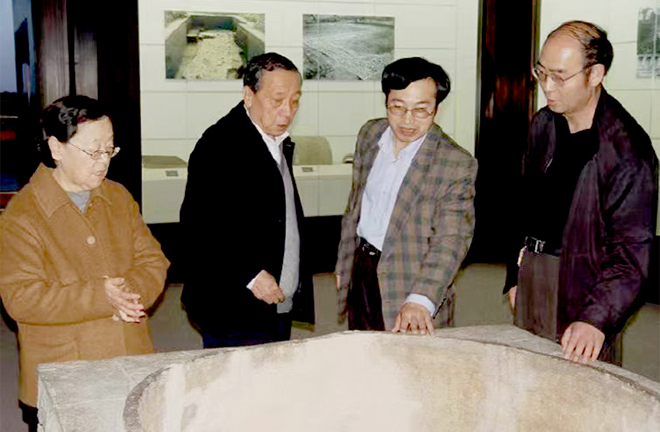Li Xueqin’s scholarly journey through Chinese history

Li Xueqin (second from left) visiting Handan Museum, Hebei, in 2005 Photo: Courtesy of GONG CHANGWEI
In July 2003, during an interview with the Chinese Social Sciences Today, Li Xueqin (1933–2019), a renowned Chinese historian and archaeologist, spoke with deep emotion about his impending retirement from the Institute of History of the Chinese Academy of Social Sciences (hereinafter referred to as the “Institute”), where he had dedicated 50 years of his life. Reminiscing on his career, he remarked, “My entire life is inseparable from the Institute. I grew up at the Institute, and all my achievements were made there.”
Theoretical framework
The summer of 1952 marked a turning point in Li’s academic career when he was invited to the Institute of Archaeology of the Chinese Academy of Sciences to participate in compiling the book Piecing Together Oracle Bone Inscriptions of the Yin Ruins. After formally joining the Institute, Li began working alongside Chinese historian Hou Wailu (1903–1987) as his assistant, which significantly shaped his scholarly character.
Li emphasized that when studying a specific branch of a discipline, such as ancient history, one should pay attention to its relations with other disciplines, including Chinese history, paleography, archaeology, and historical geography. Addressing the question of how can one identify and tackle issues within this complex academic context, Li said that Hou once advised him not to get bogged down in specific details, but to shift his attention to the comprehensive theoretical framework. This advice had a profound impacted on Li. In the 1970s, reflecting on Hou’s words, Li realized that their work should always be linked to a broader theoretical goal.
In Li’s view, the term “theory” should be understood at broader level. He kept Hou’s words in mind and often said that the study of history should be conducted within a broad scope, requiring close interdisciplinary efforts. This implies that the various branches of history should also consider historical and theoretical issues. Li’s major work, Collected Works of Li Xueqin (30 volumes), demonstrates that the entirety of his research, including his studies of oracle bone inscriptions, bronzes, Warring States period characters, and bamboo slips, was conducted from the perspective of ancient Chinese civilization.
Ancient Chinese civilization
In the preface to Chang Yuzhi’s book Research on the Calendar of Shang and Zhou Dynasties, Li wrote: “Recently, I have often thought that the study of ancient Chinese civilization should be regarded as a distinct discipline. In the world, studies of other ancient civilizations have specialized names. For example, the study of ancient Egypt is called Egyptology, the study of the ancient Mesopotamian civilizations is Assyriology, and the study of ancient Greece and Rome is called the Classics. However, the study of ancient Chinese civilization does not have a specific discipline name, probably because Chinese civilization has evolved uninterrupted. The term ‘Sinology’ used internationally cannot be equated with Egyptology or Assyriology. In fact, the origins of ancient Chinese civilization, including the Xia, Shang, and Zhou dynasties, not only differ from prehistoric China that was merely studied according to archaeological findings, but also from the periods after the Qin and Han dynasties that were well documented. The research into this period requires both textual and archaeological sources, which is similar to the study of other ancient civilizations in the world. I believe that the study of ancient Chinese civilization will eventually be recognized as an important specialized discipline.”
In August 2003, Fudan University Press published Li’s book Ten Lectures on Ancient Chinese Civilization. In reference to this work, Li wrote: “People often think that the field I’ve dedicated myself to seems to be highly diverse. However, for me, it’s simply the early stage of Chinese history, roughly corresponding to the period documented by the Records of the Grand Historian. The problem is that research on this period is hard to define—some consider it history, some archaeology, and others consider it bibliography and philology, paleography, the history of science and technology, art history, or intellectual history. It clearly demonstrates the interdisciplinary nature of this field. I think the best name for this field is ‘Research on Ancient Chinese Civilization.’” Additionally, Li cited the views of K. C. Chang and Dr. Cao Bingwu, who referred to this discipline as the new “Pre-Qin History” or simply “Chinese Civilization History.” Li largely agreed with their views, but still felt that “Research on Ancient Chinese Civilization” might be more appropriate.
Today, Research on Ancient Chinese Civilization has become one of the most dynamic, attractive, and compelling disciplines. The year 2023 marks the 90th anniversary of Li’s birth and the fifth anniversary of his passing. In remembrance of our esteemed mentor, we will carry on his legacy with dedication and perseverance.
Gong Changwei is a research fellow from the Institute of History at the CASS.
Edited by REN GUANHONG

 PRINT
PRINT CLOSE
CLOSE